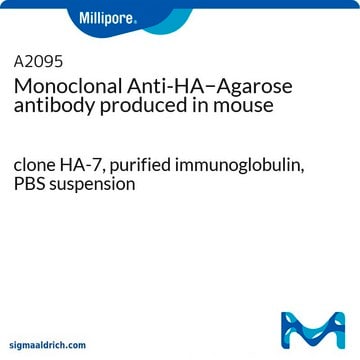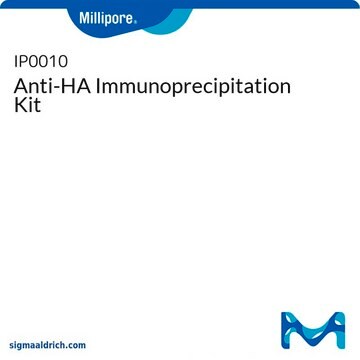SAE0197
Anti-HA Magnetic Beads
Magnetic agarose, suspension
Synonym(s):
HA beads
Sign Into View Organizational & Contract Pricing
All Photos(1)
About This Item
UNSPSC Code:
12352203
NACRES:
NA.56
Recommended Products
Related Categories
General description
Anti-HA Magnetic Beads are a conjugate of high-affinity mouse IgG1 monoclonal anti-HA antibody against HA tag (YPYDVPDYA) derived from human influenza the hemagglutinin (HA) protein. The high degree of charged amino acids in the HA-tag enhances its potential for strong antibody recognition. This product may be used for purification of HA-tagged proteins that are expressed in bacterial and mammalian cell lysates.
Application
These anti-HA magnetic agarose beads may be used in various immunological techniques, such as immunoprecipitation, immunoaffinity purification, ubiquitination assay.
Features and Benefits
- Antibody is conjugated to cyanogen bromide-activated magnetic agarose beads.
- Protein-to-beads ratio ~ 4 mg/mL.
- High specificity binding to HA-tagged proteins.
Other Notes
This product is for R&D use only. Not for drug, household, or other uses. Please consult the Safety Data Sheet for information regarding hazards and safe handling practices.
Storage Class
12 - Non Combustible Liquids
wgk_germany
WGK 3
Certificates of Analysis (COA)
Search for Certificates of Analysis (COA) by entering the products Lot/Batch Number. Lot and Batch Numbers can be found on a product’s label following the words ‘Lot’ or ‘Batch’.
Already Own This Product?
Find documentation for the products that you have recently purchased in the Document Library.
BMI1 induces ubiquitination and protein degradation of Nod-like receptor family CARD domain containing 5 and suppresses human leukocyte antigen class I expression to induce immune escape in non-small cell lung cancer
Zhi-Hui Lu, et al.
The Kaohsiung Journal of Medical Sciences, 38(12) (2022)
Zhi-Hui Lu et al.
The Kaohsiung journal of medical sciences, 38(12), 1190-1202 (2022-10-05)
The Nod-like receptor (NLR) family CARD domain containing 5 (NLRC5) has been reported as an activator of human leukocyte antigen (HLA) class I that is responsible for immune activity in cancer treatment. This work focuses on the role of BMI1
Control of histone demethylation by nuclear-localized ?-ketoglutarate dehydrogenase
Huang F, et al.
Plant Science, 381 (6654) (2023)
Our team of scientists has experience in all areas of research including Life Science, Material Science, Chemical Synthesis, Chromatography, Analytical and many others.
Contact Technical Service








